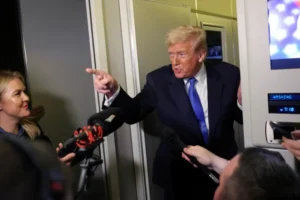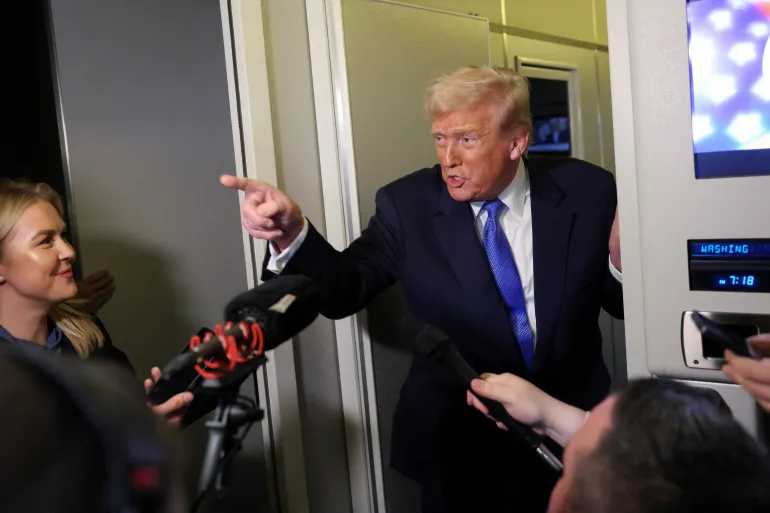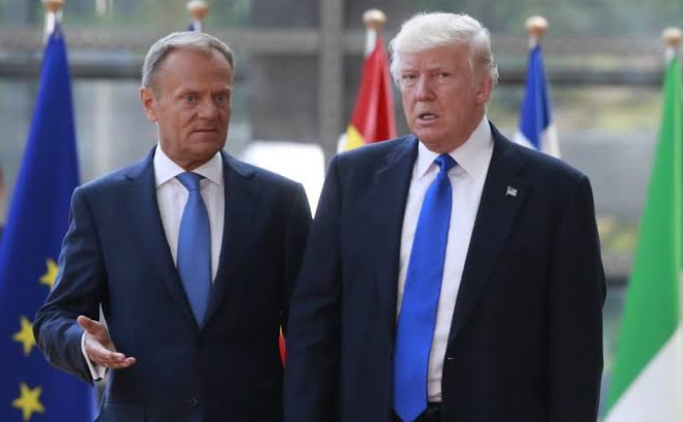Trump declines to rule out US recession as tariffs spook investors
In recent weeks, President Donald Trump has implemented a series of tariffs targeting key U.S.
trading partners, notably Canada, Mexico, and China. These measures have introduced significant volatility in financial markets and raised concerns about a potential economic recession.
In a recent interview, President Trump declined to dismiss the possibility of an economic downturn, stating, “I hate to predict things like that. There is a period of transition, because what we’re doing is very big. We’re bringing wealth back to America.”
Market Reactions and Investor Sentiment
The imposition of tariffs has had immediate repercussions on financial markets. The Dow Jones Industrial Average experienced a notable decline, erasing gains made since Trump’s inauguration.
Similarly, the S&P 500 index fell by 3.8% since January 20, signaling heightened investor anxiety. Major corporations, including tech giants like Tesla and Netflix, have seen their stock prices dip below critical support levels, further exacerbating market unease.
Jeffrey Solomon, president of TD Cowen, expressed concerns about the broader economic implications of the tariffs, warning that they could trigger a chain reaction leading to a recession.
He highlighted the potential for disrupted supply chains and reduced business investments as companies grapple with the new trade landscape.
Divergent Views Within the Administration
Within the Trump administration, opinions on the potential for a recession appear divided. Commerce Secretary Howard Lutnick dismissed recession fears, asserting that the U.S. is poised for substantial growth in the coming years.
He emphasized that the tariffs are strategic measures aimed at compelling trading partners to address issues like illegal immigration and drug smuggling.
Conversely, Treasury Secretary Scott Bessent acknowledged that the economy might face a “rough patch” as it adjusts to reduced reliance on government spending and the new tariff structures.

He noted that while employment remains stable, there is uncertainty about future job security amid potential government layoffs and the broader economic impact of the tariffs.
Economic Indicators and Forecasts
Economic indicators present a mixed picture. The Federal Reserve Bank of Atlanta’s GDPNow tracker forecasts a 2.8% contraction in GDP for the first quarter, signaling potential economic headwinds.
Additionally, consumer sentiment has declined, reflecting public apprehension about the economic outlook.
Economists are increasingly concerned that the tariffs could lead to stagflation—a scenario characterized by high inflation and stagnant economic growth.
The potential for retaliatory tariffs from affected countries further exacerbates these fears, as they could disrupt global supply chains and dampen international trade.
Global Implications and Trade Relations
The tariffs have strained relations with key trading partners. Canada and Mexico, both targets of the recent tariffs, have expressed dissatisfaction and are considering reciprocal measures.
China, facing additional tariffs, has also signaled potential retaliation, raising the specter of a full-scale trade war.
Such developments could have far-reaching implications for the global economy.
Disrupted trade relationships may lead to increased prices for consumers, shortages of certain goods, and a slowdown in global economic growth. Businesses worldwide are bracing for the impact, reassessing supply chains, and considering shifts in production to mitigate potential losses.
Domestic Policy Responses
In response to the economic uncertainty, the administration is contemplating various policy measures.
Discussions include potential tax adjustments, infrastructure investments, and initiatives aimed at supporting industries most affected by the tariffs.
However, the effectiveness of these measures remains a topic of debate among economists and policymakers.
The Federal Reserve faces a challenging environment, balancing the need to control inflation with the imperative to support economic growth.
Decisions regarding interest rates will be closely scrutinized as the central bank navigates these complex dynamics.
Public Perception and Political Ramifications
The economic developments have significant political implications. Public perception of the administration’s handling of the economy could influence upcoming elections and shape the broader political landscape.
Critics argue that the tariffs may harm more than they help, potentially leading to job losses and higher consumer prices.
Supporters, however, contend that the measures are necessary to protect domestic industries and assert U.S. interests on the global stage.
They argue that short-term pain may be a requisite for long-term gain, positioning the U.S. for a more favorable economic future.
Conclusion
As the U.S. embarks on this contentious economic path, the full impact of the tariffs remains uncertain.
While some indicators suggest potential challenges ahead, the administration maintains that these measures are part of a broader strategy to revitalize the American economy.
The coming months will be critical in assessing the efficacy of these policies and their implications for both the domestic and global economic landscape.






